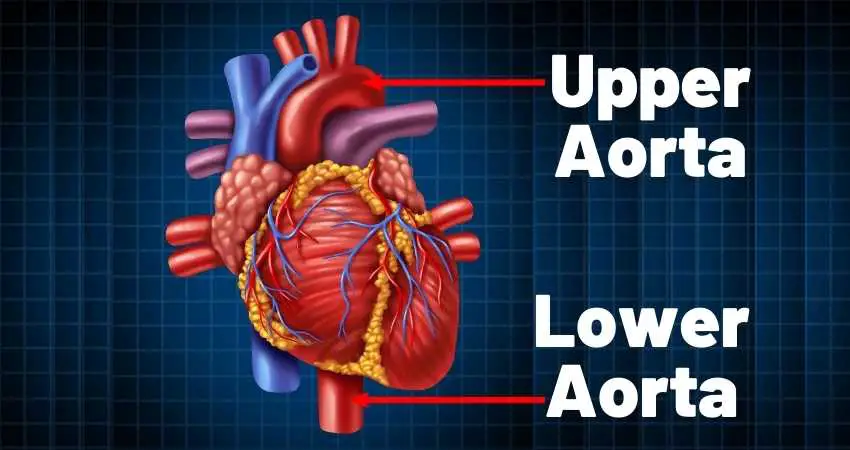Aortic dissection is a serious condition that can be fatal. While it can be caused by high blood pressure, it’s intriguing to discover how it can affect it. What is the aortic dissection effect on blood pressure?
Aortic dissection can result in a blood pressure difference larger than 20 mmHg between the limbs on the right and left side of the body. In addition, it can cause low blood pressure caused by decreased blood flow or an interruption. Although they are common, a difference between the limbs or low BP doesn’t have to be present during an aortic dissection.
There are many ways an aortic dissection is diagnosed. A patient’s blood pressure can help determine if one has occurred, especially in cases without the typical pain. This article will inform you all ways BP is affected. In addition, you might be surprised to learn how much of a difference between arms were recorded in actual cases.
BP Tip: You can lower BP naturally by changing how you breathe. There’s a device approved by the FDA and The American Heart Association. It guides your breathing a few minutes a day which has been proven to lower BP. You can check it out in the manufacturer’s website by clicking here.
Disclaimer: Some links in this article are affiliate links which means I may earn a small commission at no extra cost to you. As an Amazon associate I earn from qualifying purchases.
How Aortic Dissection Affects Blood Pressure
Depending on the location of the aortic dissection along the aorta, blood pressure may be different between the left and right arms or legs. Without a dissection, a slight difference is normal. It’s not unusual to have a difference up to 10 mmHg. A larger difference could indicate several medical conditions, including aorta dissection1. This is one of many reasons why blood pressure should be taken in both arms, especially in the first physician visit2. I wrote about this in detail in my blog post, Which Arm To Take Blood Pressure. Regardless of aortic dissection, you’ll want to find out why both arms should be measured.
A case report, published in 2016, tells a story of a 35 year-old woman who was admitted into intensive care. She was suffering from a structural heart disorder and related lung complications. Their initial investigation determined blood pressure was significantly higher on the left arm. Testing showed she had an abdominal aorta dissection. They didn’t mention how much higher the BP on the left arm was. Unfortunately, after surgery and treatment, she passed away ten days later3.
A report, published in 2013, informs us of a 68 year-old female who was checked into the emergency department. When they checked her blood pressure, she was found to have dangerously high blood pressure. On her left arm, blood pressure was 206/102 mmHg and her right arm measured 243/129 mmHg. Her diagnosis was an underlying aortic aneurysm and chronic aortic dissection4. The patient was treated and was monitored for at least two more years.
In 2006, a 63 year-old woman fainted in her home and was removed to the hospital. It was determined she suffered from an aortic dissection. During the initial examination, her blood pressure showed a difference of 40 mmHg between her right and left arms. Her left arm measured 110/70 mmHg and her right arm 70/30 mmHg5.
A man in his early 60s was admitted into the hospital and diagnosed with a thoracic aortic dissection. His right arm blood pressure was 152/68 mmHg and his left arm was 167/62 mmHg, a 15 mmHg difference. He received surgery and was discharged four days later in stable condition6.
While blood pressure differences between the limbs are a common symptom, when its absent, aortic dissection cannot be ruled out. In a case study of 102 patients, 62% did not have pulse or blood pressure differences between the left and right side7.

Why Aortic Dissection Causes Blood Pressure Higher or Lower in One Arm or Leg
To understand how blood pressure is affected, it’s important to describe what happens during an aortic dissection. The aorta, which is the largest artery in the body, carries oxygen rich blood from the heart to your body. It’s about an inch in diameter and a foot long, similar to a garden hose. It rises up from the left side of the heart, curves over it and travels down through the chest to the stomach area.
An aortic dissection occurs when the inner layer of the aorta tears. The blood flows through the tear causing the inner and middle layers of the aorta to separate from each other. The area between the two separated layers fills with blood. If the blood breaks through the outer wall of the aorta, the rupture often causes death.
The tear can occur in the upper part of the aorta, known as type A, or the lower part, called Type B. The Type A is more common and dangerous. The dissection can lead to internal bleeding, organ damage or heart valve damage.
The dissection can interrupt the blood flow throughout the body. If the blood flow to the brain is decreased, it can lead to a stroke. Most patients complain of severe pain in the stomach, chest or back. There may be shortness of breath, weakness and pain in the legs or arms. The changes in blood flow to different parts of the body can cause the differences in blood pressure between the right or left side of the body ((Journal Circulation: Aortic Dissection)).
Does Aortic Dissection Raise or Lower Blood Pressure?
Research has shown in some cases blood pressure is high while in others, low blood pressure is one of the symptoms8. An aortic dissection can decrease blood flow which results in low blood pressure9.
A study released in 2009, examined aortic dissection cases over the prior 15 years. A higher percentage of patients younger than 40 years in age did not have high blood pressure. Patients who were aged 70 or more years were found to have blood pressure equal or higher than 150/90 mmHg10.
The story of a 57 year-old woman with an aortic dissection was published in 2020. She was removed to the hospital because she suddenly collapsed while undergoing therapy for an ankle injury. In the hospital, her blood pressure measurement was 87/53 mmHg. Luckily, she was checked out of the hospital nine days later after surgery ((National Center for Biotechnology Information: Acute aortic dissection presenting as status epileptics)).
How Aortic Dissection Treatment Can Affect Blood Pressure
After a diagnosis of an aortic dissection is made, one of the main treatments is to control the tear in the aorta. To accomplish this, blood pressure is reduced as much as possible. Typically, beta-blockers or calcium channel blockers is prescribed to lower it.
There is much pain with an aortic dissection. The pain and stress can cause blood pressure to rise, and that’s the last thing anyone wants. Pain medications will typically be prescribed to help control the stress of the pain which can help keep BP lower11.
Read Next
Which Arm To Take Blood Pressure
 ( Lower Your BP Naturally, In Only 30 Days Or Pay Nothing…Visit Website By Clicking Here Or Photo Above )
( Lower Your BP Naturally, In Only 30 Days Or Pay Nothing…Visit Website By Clicking Here Or Photo Above )
- National Center for Biotechnology Information: Aortic Dissection [↩]
- Journal Of The American College Of Cardiology: 2017 ACC/AHA/AAPA/ABC/ACPM/AGS/APhA/ASH/ASPC/NMA/PCNA Guideline for the Prevention, Detection, Evaluation, and Management of High Blood Pressure in Adults [↩]
- National Center for Biotechnology Information: Discrepancy in blood pressure between the left and right arms – importance of clinical diagnosis and role of radiological imaging [↩]
- National Center for Biotechnology Information: Conservative Management of Chronic Aortic Dissection with Underlying Aortic Aneurysm [↩]
- National Center for Biotechnology Information: Silent Aortic Dissection Presenting as Transient Locked-In Syndrome [↩]
- National Center for Biotechnology Information: Nearly Asymptomatic Eight-Month Thoracic Aortic Dissection [↩]
- National Center for Biotechnology Information: Acute aortic dissection presenting as status epileptics [↩]
- National Center for Biotechnology Information: Acute aortic dissection: pathogenesis, risk factors and diagnosis [↩]
- U.S. National Library of Medicine: Familial thoracic aortic aneurysm and dissection [↩]
- National Center for Biotechnology Information: Acute Aortic Syndromes and Thoracic Aortic Aneurysm [↩]
- Journal Circulation: Aortic Dissection [↩]